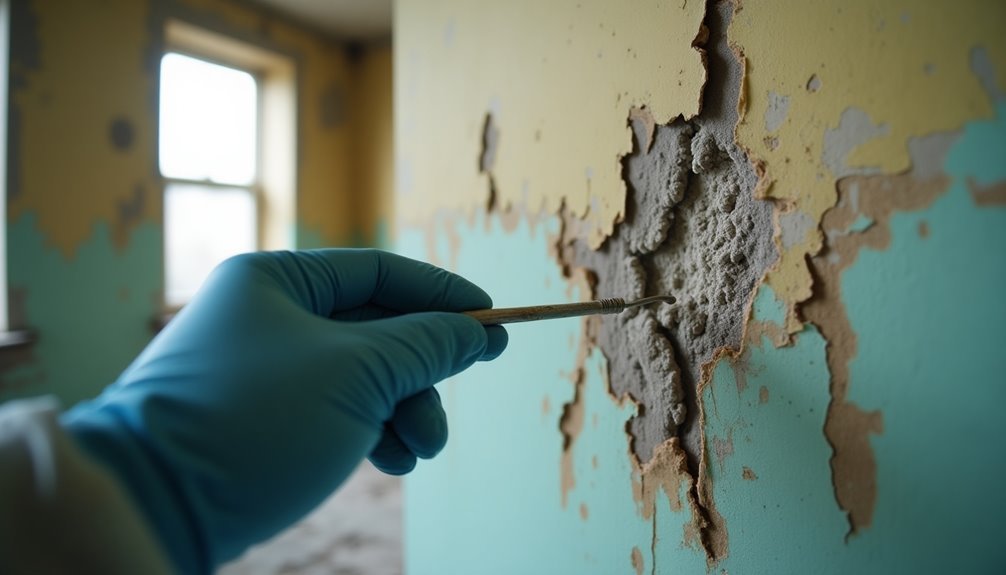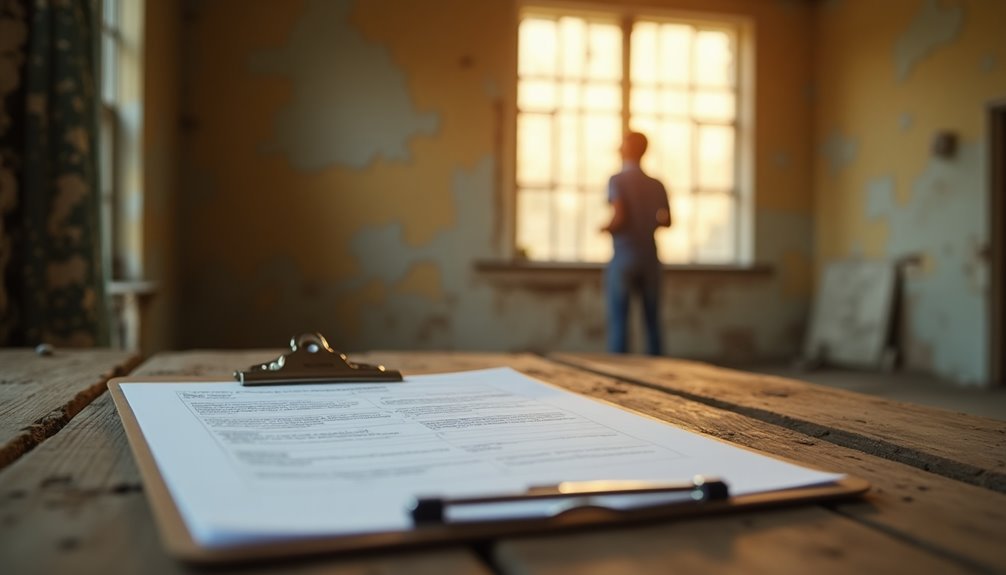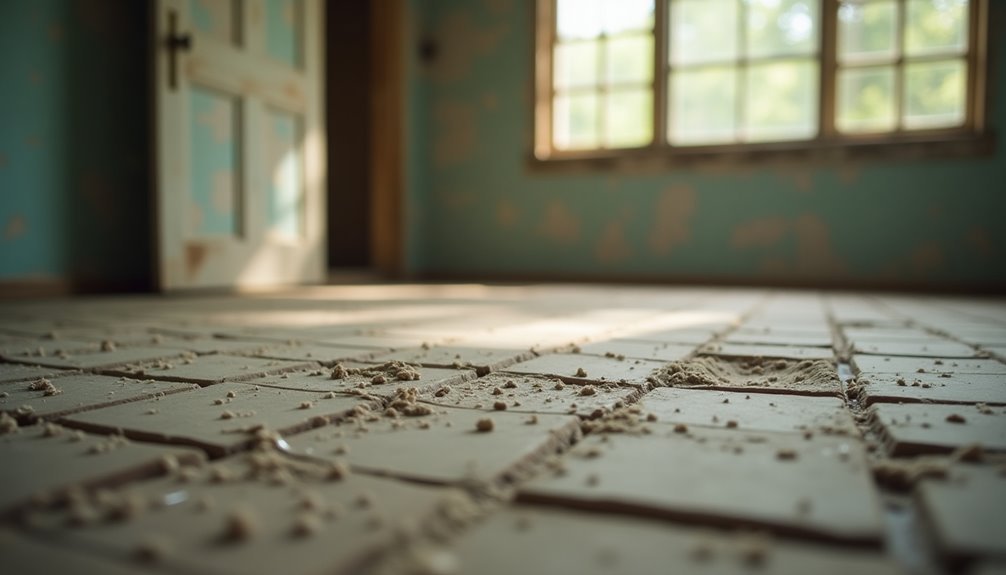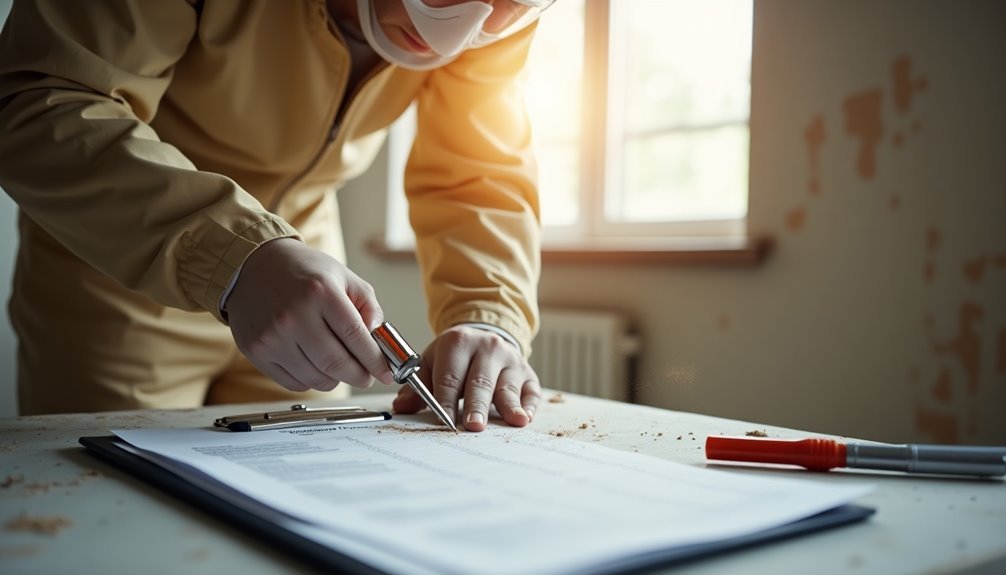Asbestos testing is crucial before any renovations or home sales. Inhaling asbestos fibers can lead to serious health issues like lung cancer and mesothelioma, sometimes surfacing decades later. Legally, federal and state regulations demand testing, especially for homes built before 1980, to avoid hefty fines. Additionally, identifying asbestos can enhance your property's market value; homes free of asbestos attract more buyers and often sell for 5-15% more. Proper testing, conducted by certified inspectors, helps ensure a smooth renovation and compliance. Understanding these aspects can significantly impact your decisions and outcomes, making further exploration worthwhile.
Health Risks of Asbestos

When considering renovations, it's vital to recognize the serious health risks associated with asbestos exposure. Inhaling asbestos fibers can lead to devastating conditions, including lung cancer, mesothelioma, and asbestosis. You might not notice asbestos symptoms right away; these diseases often develop over decades, with latency periods extending upwards of 30 years. Asbestosis, for example, causes a slow accumulation of scar tissue in your lungs, leading to breathing difficulties and potentially severe heart complications. Notably, long-term exposure can significantly increase your risk of developing these life-threatening diseases.
You should also be aware that the risk increases significantly if you smoke tobacco alongside asbestos exposure. While pleural plaques and thickening might seem benign, they can signal more serious future health issues. These nonmalignant disorders can still impair respiratory function and indicate cumulative exposure to asbestos fibers.
Ultimately, the long-term consequences of asbestos exposure are serious, and they can manifest well after your initial contact. Ensuring that your renovation site is free of asbestos is crucial for safeguarding your health and that of your family. Don't take these risks lightly—being informed is your first step toward liberation from potential health hazards.
Legal Requirements for Testing
Understanding the legal landscape surrounding asbestos testing is imperative for homeowners planning renovations. You must navigate both federal and state regulations to ensure compliance. Federal asbestos regulations require testing before any renovation or demolition under the National Emission Standards for Hazardous Air Pollutants (NESHAP). This includes homes built before 1980, where the Environmental Protection Agency (EPA) strongly recommends testing.
| Type of Regulation | Requirements | Consequences of Non-Compliance |
|---|---|---|
| Federal Regulations | Asbestos testing before renovations or demolitions | Fines and legal actions |
| State-Specific Laws | Disclosure of known ACMs in residential properties | Legal consequences, including lawsuits |
| Local Authorities | Permits may be needed for removal or renovation | Fines for unauthorized work |
Testing procedures must be conducted by certified inspectors to facilitate safe renovations. Asbestos surveys are crucial for protecting public health and minimizing exposure to hazardous materials. Ignoring these requirements can lead to severe legal repercussions. By understanding and adhering to asbestos regulations, you safeguard your health and financial future during renovations.
Financial Benefits of Early Testing

Early asbestos testing offers significant financial advantages that can greatly impact your renovation plans. By identifying asbestos issues upfront, you can avoid unexpected and costly remediation processes that disrupt your budget and timeline. Incorporating potential remediation costs into your financial planning can lead to substantial cost savings in the long run. The sooner you detect asbestos, the less likely you'll face extensive removal and cleanup operations that escalate with severity.
Additionally, properties free from asbestos tend to have higher market value and are more appealing to potential buyers or tenants. Addressing any asbestos-related issues not only enhances your property's marketability but also makes it more insurable, allowing you to secure favorable insurance terms.
Moreover, early testing minimizes long-term costs associated with deterioration and extensive handling procedures in the future. Consistent monitoring and maintenance prevent significant financial troubles stemming from contamination.
Finally, tackling asbestos issues early mitigates the economic impact of exposure, which can lead to costly medical expenses and loss of productivity. By prioritizing asbestos testing, you invest in a safer, more financially sound future for your renovations.
Planning Renovations Safely
When planning your renovations, it's crucial to identify any potential asbestos risks in your home. Knowing what materials contain asbestos helps you ensure compliance with local regulations and safety measures. By addressing these aspects upfront, you can execute your project smoothly and avoid costly setbacks later on.
Identifying Asbestos Risks
Many homeowners overlook the potential risks of asbestos lurking in their properties, especially in homes built before the 1980s. To plan renovations safely, it's crucial to identify asbestos-containing materials through effective asbestos identification techniques. Common materials that may contain asbestos include vinyl floor tiling, popcorn ceilings, and insulation around pipes. Vermiculite insulation, often found in attics, poses significant risks due to its tendency to release harmful fibers into the air.
When you're assessing your home for potential hazards, pay attention to other materials like cement sheets, textured paints, and soundproofing materials. Even if these materials appear undisturbed, damaging them during renovations can release microfibers that lead to serious health issues, such as lung cancer and asbestosis.
Understanding where asbestos might be present allows you to take proactive steps, ensuring your renovation activities don't compromise your health or safety. Before you start any demolition or changes, conduct thorough testing to identify these risks. If asbestos is found, you'll need to develop an abatement plan to effectively manage the situation, protecting yourself and those who enter your home.
Ensuring Compliance Measures
Ensuring compliance measures during renovations involves meticulous planning and execution to safeguard both health and legal standing. You must adhere to compliance guidelines set forth by regulatory frameworks like the National Emission Standards for Hazardous Air Pollutants (NESHAP) under the Clean Air Act. Asbestos testing is mandatory before any renovation or demolition, regardless of your building's age. Be aware that state and local regulations, such as Oregon's requirement for asbestos surveys in buildings built before January 1, 2004, may impose additional obligations.
Engage accredited asbestos inspectors for thorough surveys, ensuring samples are analyzed by certified laboratories. Non-compliance can lead to severe fines and legal repercussions, emphasizing the necessity of following these guidelines closely. By identifying potential asbestos hazards early on, you can strategically plan renovations, ensuring that areas likely to be disturbed are appropriately tested. This proactive approach not only protects your project's integrity but also prioritizes the health of workers and residents by preventing hazardous fiber exposure. Provide licensed contractors with the survey results to manage or remove asbestos safely, reinforcing your commitment to a compliant and safe renovation process.
Impact on Property Value

When you consider selling a property with asbestos, you'll notice that buyers often lean towards asbestos-free homes, significantly affecting your potential market value. Not only does the presence of asbestos deter buyers, but it also leads to higher insurance premiums and costly removal expenses that can burden your finances. Understanding these implications can help you make informed decisions about your property and its future.
Asbestos-Free Properties Attract Buyers
Desirability is a key factor driving the real estate market, especially when it comes to properties free from asbestos. As a potential seller, showcasing an asbestos-free home significantly boosts buyer interest. These properties attract more buyers due to the reduced health risks and financial burdens, making them more appealing in today's market.
Buyers are increasingly aware of the dangers associated with asbestos, which compels them to seek homes that have been tested and cleared. They often request thorough inspections to confirm the absence of this hazardous material before committing to a purchase. This heightened awareness translates into strong market demand for asbestos-free homes, allowing sellers to command better prices.
Homes identified with asbestos typically sell for 5-15% less than similar, asbestos-free properties. In high-stakes negotiations, the presence of asbestos can lead to reduced offers or even potential buyers walking away from deals. Ultimately, removing asbestos not only enhances marketability but also positions your property as a lower-risk investment, enabling you to leverage its value effectively. By prioritizing asbestos testing and removal, you can liberate your property's full potential in a competitive real estate landscape.
Insurance Implications and Costs
Selling an asbestos-free property can significantly enhance its appeal, but it's also important to understand the insurance implications and costs associated with asbestos presence. Insurance policies often have exclusions for asbestos-related damages, which means you could be fully responsible for any associated costs. If you discover asbestos during renovations, you might face elevated premiums due to the heightened health risks and removal expenses.
Moreover, each homeowner's insurance policy varies, making it essential to consult your insurance company about specific testing requirements and coverage details. If an asbestos issue arises from a covered peril, you may find partial coverage, but this is not guaranteed.
The financial burden of asbestos removal can be substantial, often running into thousands of dollars, especially if contamination is widespread. Unplanned discoveries can lead to urgent abatement services, significantly driving up costs. Additionally, failing to conduct proper asbestos testing can result in fines, legal claims, and delayed projects. Remember, disclosing any asbestos presence during property transactions is legally required and can impact your property's market value, making it critical to address these issues proactively.
Insurance Considerations
Navigating insurance considerations for asbestos testing before renovations is crucial for homeowners looking to protect their investments. First, you should understand your insurance policies and their specific coverage limits regarding asbestos. Generally, insurance may cover asbestos testing if it's related to damage from a covered peril, such as fire or flooding. However, you need documented proof of asbestos release due to this damage to qualify.
Be aware that most home insurance policies exclude pollution-related issues, including asbestos, unless part of repairs from a covered loss. This means you might need to bear the financial burden of testing and removal out-of-pocket if it's not linked to an incident your policy covers. It's wise to review your policy documents thoroughly and consult your insurance company for clarity on what's included.
Additionally, keeping in mind that professional asbestos removal is often required for insurance coverage can save you from potential complications. If you're planning to sell or renovate, ensuring compliance with these considerations will not only protect you financially but also enhance the safety and marketability of your property.
Practical Testing Methods

Before embarking on renovations, understanding practical testing methods for asbestos is essential to ensure a safe and compliant environment. Start with a visual inspection conducted by certified asbestos inspectors who identify suspect materials in common areas like flooring, ceiling tiles, and insulation. Asbestos sampling is a careful process; samples must be collected with precision to prevent airborne fiber release. Once gathered, these samples are placed in appropriate containers and sent to accredited laboratories for analysis.
Laboratories typically use Polarized Light Microscopy (PLM) to identify asbestos in solid materials. For airborne fibers, Transmission Electron Microscopy (TEM) is standard, especially for smaller particles. Results usually arrive within a few days, allowing you to plan your renovations accordingly.
During construction activities, air testing is crucial to ensure fiber levels remain safe. Phase Contrast Microscopy (PCM) gauges fiber concentrations in the air, while TEM provides detailed identification. Additionally, soil and water testing can identify environmental contamination from asbestos. By understanding and implementing these testing procedures, you can liberate your renovation project from the hidden dangers of asbestos, promoting a safer living environment.
Role of Certified Inspectors
When it comes to ensuring a safe renovation, the role of certified inspectors can't be overlooked. These professionals are essential in identifying asbestos-containing materials (ACM), which can pose serious health risks if disturbed. To qualify, inspectors must meet specific certification requirements, often mandated by state or federal regulations. In New York, for example, an "Inspector Certificate" from the NYSDOL is mandatory, along with completion of accredited training programs.
The inspection process begins with a thorough survey of the building, assessing potential hazards. Certified inspectors collect samples for laboratory analysis, ensuring accuracy in identifying ACM. Their training covers crucial topics like the health effects of asbestos and safe sampling methods, typically lasting from two to five days. Moreover, inspectors prepare detailed reports that include worksite dimensions, diagrams, and photographs, which are vital for understanding the potential risks involved.
Compliance with local, state, and federal regulations is also a key responsibility, as inspectors enforce asbestos management standards. By conducting safety investigations and coordinating with city agencies, certified inspectors protect public health, ensuring your renovation project remains safe and compliant. Their expertise is indispensable for a successful, worry-free renovation.
Conclusion
Before diving into renovations or selling your home, remember that nearly 1 in 3 homes built before 1980 contain asbestos. By prioritizing asbestos testing, you not only safeguard your health and comply with legal requirements but also protect your financial investment. Early detection can save you from costly remediation down the line and enhance your property's value. Don't overlook the importance of hiring certified inspectors to ensure a thorough assessment—your peace of mind is worth it.
